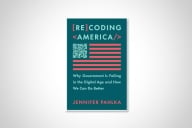You have /5 articles left.
Sign up for a free account or log in.
As longtime readers know, my academic training was in political science, with a focus on political philosophy. Day three of SHEEO was a club sandwich of poli sci; I almost felt guilty by the end of it. Almost.
The morning plenary was by Deondra Rose, of Duke. She offered an argument about the efficacy of political action in generating conditions of equality for women, drawing largely on the political history of the US in the second half of the twentieth century. She focused largely on access to higher education, noting the well-known findings within political science that tie increased political engagement – voting, volunteering, even running for office – with increased formal education. Access to higher education took a series of legal changes, not all of which were done either deliberately or consciously. By her telling, Rep. Carl Elliott (D-AL) had been a champion of expanding higher education for years, introducing and reintroducing bills to help low-income students and having them blocked. But when the Soviets launched Sputnik and Americans, as Rose put it, “freaked out,” Elliott saw his moment. He renamed the bill the National Defense Education Act, tying expanded access to higher education to national security. It passed, and opened the doors for women around the country.
Apparently, the folks Elliott intended to help were low-income white men like he had been, but he wasn’t that precise in his language. Since he didn’t specify, he inadvertently created a massive benefit for women, too; Rose called him an “accidental egalitarian.”
Title IX, which occupied a good part of her talk, was apparently slipped into a massive omnibus budget bill without most of Congress noticing. Rose called the maneuver “stealth politics.” Whether stealth politics is strategic or anti-democratic, of course, is a bit of a judgment call. I’d argue that the last decade or so has demonstrated amply that we should be wary of it. The larger point, though, was that political wins like those both required, and later enabled, political involvement.
She ended the story there, to my disappointment. The number of women attaining bachelor’s degrees surpassed the number of men in a given year by the early 1980’s, and the gap continues to widen. Yet as she noted, men still dominate Congress, the Courts, and the Presidency. Solutions now aren’t as straightforward as they once were. But the moral about the need for political involvement stands.
The middle slice of the club sandwich, the mid-day plenary, focused on the current federal role in higher education policy. The short answer is that we’re in a period of punctuated equilibrium. Congress is so deadlocked that the Higher Education Act is years overdue for reauthorization, and nobody really expects it to happen anytime soon. Because Congress has been stuck, the executive branch has fallen back on executive actions to get things done. But that approach has natural limits. For one, we’ve had abrupt changes in administrations and wildly differing priorities, as the on-again, off-again fate of “gainful employment” rules has shown. The Obama administration wanted it, the Trump administration rescinded it, and the Biden administration wants it again. What Emmanuel Guillory called “ping-ponging” doesn’t allow the bureaucrats in the administrative agencies clear consistent guidance.
Worse, as Rebecca Natow pointed out, the judicial branch is starting to drop its traditional deference to elected branches (and precedent) and simply tossing out anything it doesn’t like. That adds to the murkiness; as Guillory put it, “the constant gray space is not a safe space.” So by default, major issues are devolving to the states.
In the states, the opposite dynamic holds. Most states effectively have one-party control, and in many of those, the only accountability for most elected officials is through primaries, in which they live in fear of being judged impure by the truest of true believers.
The final panel of the day addressed some consequences of that devolution. Nicole Washington and Chris Mathias discussed the “divisive concepts” laws that have been enacted in Florida and Idaho, respectively. (Mathias is a member of the Idaho House of Representatives.) Given the nature of the discussion, I’ll tread lightly here, but I think it’s fair to report that in his talk, Mathias referred to the poli sci classic “The Semisovereign People,” by E. E. Schattschneider. I gave a little cheer from my seat. Schattschneider’s book is about how controlling the scope of a conflict can change its likely outcome. Expanding the number of people involved in a political battle – what Schattschneider called “socializing the conflict” – affects the odds. Similarly, restricting participation – :”privatizing the conflict,” in Schattschneider’s language – tends to favor the party with more power at the outset. In that light, for example, labor unions can be seen as efforts to socialize the process of wage negotiation in order to improve the outcome for workers. Forced arbitration clauses can be seen as the countermove.
Schattschneider’s framing suggests that Rose’s embrace of “stealth politics” may be more dangerous than she let on, depending on the context.
Political scientists think this way. This may be why we don’t get invited to many parties.
The rest of the panels were somewhat more optimistic. I was blown away by the panel on postsecondary completion initiatives in Tennessee. The presenters – Samantha Gutter, Krissy DeAlejandro, and Susan Rhodes went very quickly through some of the program names, most of which sounded alike, so I won’t try to reconstruct which program led to which intervention. But the short version is that the combination of free community college for high school students, free community college for returning adults, emergency grants, and foundation-funded wraparound supports in the high schools has dramatically improved the collegegoing rate and the college graduation rate. In 2011, by Gutter’s telling, the percentage of adults in Tennessee with a post-secondary credential was 32.1. By 2019, it was 46.8. That doesn't happen by accident.
I was focused in particular on the emergency grants. Rhodes noted that in the more rural parts of the state, the lack of broadband renders some laptops unusable. (“Drive around rural Western Tennessee with me for a while, and you’ll want to throw your phone out the window.”) The relative paucity of public transportation options in many of the rural parts of the state meant that gas cards were the most effective intervention for many students. That was less true in urban areas, where broadband and public transportation were more available.
Part of the wraparound support model involved some very forward coaches. As Rhodes put it, “if high school students aren’t rolling their eyes at us by Christmas of their senior year, we haven’t done our job.” But it seems to work; Gutter noted that the first fall-to-fall retention rate has gone from 32 percent to 82 percent since they introduced the combination of intrusive coaching (“on the social work model”) and emergency grants. It’s hard to argue with numbers like those.
Still, kudos to the panel for noting that even terrific topline numbers like those hide worsening racial disparities. COVID made those disparities worse, as they did across the country. They didn’t offer a fresh solution, but given what they’ve done so far in a very red state, I have to tip my cap.
This post is already long; I’ll save the rest for tomorrow. Suffice it to say that folks are asking a lot of the right questions, and some of the answers are genuinely heartening. Well done, SHEEO!



